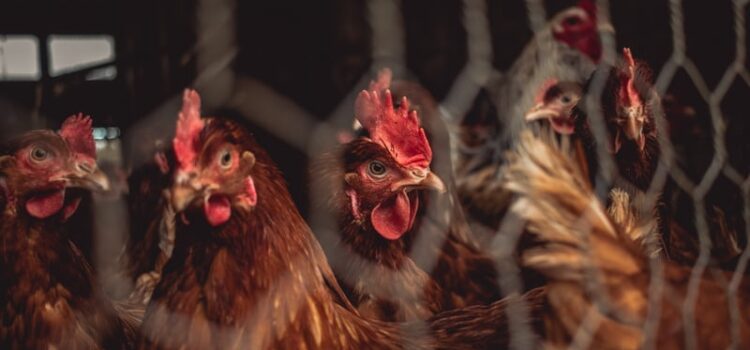

This article is an excerpt from the Shortform book guide to "Fast Food Nation" by Eric Schlosser. Shortform has the world's best summaries and analyses of books you should be reading.
Like this article? Sign up for a free trial here .
Does the meat industry have animal cruelty? What kinds of conditions do animals face?
It’s first worth noting that the fast food industry and meatpacking industry go through great efforts to stop people from seeing the full extent of animal cruelty in their industry. But animals face constant suffering until their deaths.
Read more about the meat industry and animal cruelty below.
Animal Cruelty in the Meat Industry
It’s no secret that the meat industry relies on animal cruelty. But not only are animals exploited, but their treatment throughout their lives also is brutal and filled with suffering.
Harsh Conditions in the Feedlot
E. coli has likely been present in American cattle herds for decades. But until the rise of industrial-scale, centralized meatpacking driven by the demands of the fast food industry, its spread was fairly limited. The disease gets its start in the vast feedlots of today’s slaughterhouses.
These facilities are marked by appalling sanitary conditions, where the cattle are packed into close quarters, given little exercise, and splash around in pools of manure. This creates ideal conditions for bacteria to grow and make the animals sick. This is exacerbated by what the cattle are now increasingly being fed: the rendered remains of dead sheep and other cattle, as well as dead dogs and cats purchased from animal shelters. Natural herbivores, cows’ stomachs are not designed to eat other animals. Forcing them to do so is not only inhumane and cruel, but also facilitates the growth of deadly parasites in their bodies that are then passed on to the humans who eventually consume their meat.
Walking Through Blood
Truly disturbing scenes await those who visit a slaughterhouse—or the workers who toil in them. Decapitated cattle carcasses. Organs yanked out of dead animals with bare hands. Ankle-deep pools of blood. Workers severing the carotid arteries of dead cows. All of this is just part of the scenery on a typical business day in America’s meatpacking industry. And this is just what’s at the end of the line, after the cattle have already been killed. The scenery becomes even more violent as one goes further up the production line, where workers interact with live cattle.
As cattle enter the slaughterhouse from the pen, they are greeted by a worker known as the “knocker,” who shoots them in the head with a stun gun that knocks them unconscious. This individual’s job is simply to shoot cattle in the head like this as they are herded into the slaughterhouse through a narrow shoot. After they’re knocked out, the animals are shackled to a chain and lifted through the air to the next area of the factory, where they are killed and dismembered.
(Shortform note: The scenes at these facilities are so gruesome and heartrending that the meatpacking industry has gone to extraordinary lengths to prevent the public from seeing what goes on inside them. “Ag-gag” laws make it illegal to film or photograph activities at factory farms or meatpacking plants without the explicit consent of the owner—with the goal of silencing or intimidating activists who are trying to shine a light on animal abuses. These laws are on the books in Arkansas, Idaho, Iowa, Kansas, North Carolina, and Utah. Check out this New York Times article to learn more.)
The McNugget and the Poultry Industry
A similar dynamic has played out in the poultry industry. The invention of the McDonald’s Chicken McNugget in the early 1980’s reshaped how American chickens were raised and sold. It transformed a bulk agricultural commodity into a branded, manufactured, and value-added product. As such, fast food companies began to take a much greater interest in how poultry farmers raised their birds, seeking ever-greater product uniformity.
The idea behind the McNugget was simple: a boneless chicken finger-food no larger than the size of a human thumb. The early tests of the product were so successful that McDonald’s partnered with leading chicken processor Tyson Foods to ensure an adequate supply. The Arkansas-based Tyson Foods even developed a new breed of chicken exclusively to be made into McNuggets.
The success of the McNugget made McDonald’s America’s second-largest purchaser of chicken (KFC, perhaps unsurprisingly, was #1). Their massive buying power (and that of the few major chicken processors from whom McDonald’s buys, like Tyson) wrought major changes for the nation’s chicken farmers. As with beef, consolidation and concentration became the hallmarks of the industry.

———End of Preview———
Like what you just read? Read the rest of the world's best book summary and analysis of Eric Schlosser's "Fast Food Nation" at Shortform .
Here's what you'll find in our full Fast Food Nation summary :
- How the fast food industry reshaped the American economy
- How fast food marketing is manipulating you
- Why the rise of fast food has destroyed family farms across America






